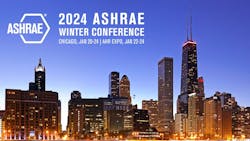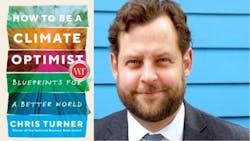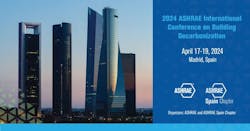Refocused on Climate, ASHRAE Eyes Chicago, Madrid
By ROB McMANAMY, with press releases
Building on the momentum and overall success of its unprecedented emergency Epidemic Task Force, the American Society of Heating, Refrigerating and Air-Conditioning Engineers (ASHRAE) will enter its 129th year focused on an even greater existential threat: climate change.
“Who could have imagined that the two things ASHRAE is most known for, indoor air quality and energy conservation, would both come to a head, with the pandemic and the climate crisis, at almost the exact same time?” said ASHRAE President Ginger Scoggins, P.E., speaking on the October episode of the HPAC On The Air podcast. “Everything feels much more urgent now. So, we are trying to operate at the speed of business and not the speed of ASHRAE,” she added.
With that in mind, on ASHRAE last month unveiled the preliminary technical program for its 2024 Winter Conference, set for Jan. 20-24, 2024, at Chicago’s McCormick Place Convention Center, coinciding as always with AHR Expo, our industry’s largest annual trade show.
“The conference gives attendees an unparalleled opportunity to discover solutions to some of the greatest challenges facing the built environment,” said Suzanne LeViseur, 2024 ASHRAE Winter Conference chair. This year’s “decarbonization focus is included within all of the technical tracks, so that we can provide effective strategies on a variety of topics.”
The technical program can be found online and in the ASHRAE 365 app. It features 11 technical tracks and more than 100 sessions, offering attendees a wide selection of topics and the opportunity to earn Professional Development Hours (PDHs) while exploring tracks such as Decarbonization and Climate Change, Clean Spaces and Mission Critical Facilities, Tall Buildings Design, Artificial Intelligence, Refrigeration and Refrigerants, and more. Some examples of decarbonization-focused sessions include:
- Decarbonization in Cold Chain Process (Refrigeration Track);
- The Logical Way to Tap Into Decarbonization: Hydronic District Energy Systems (Hydronic Systems Track);
- Beneficial Electrification (HVACR Systems and Equipment Track);
- Grid-Interactive Buildings for a Decarbonized World (Decarbonization and Climate Change Track).
Grid-Interactivity Guide
Regarding “Grid-Interactive Buildings,” ASHRAE on Nov. 2 released a new guide focusing on the critical role that grid interactivity is now poised to play. The Grid-Interactive Buildings for Decarbonization: Design and Operation Resource Guide is the second in a series of guides developed by the ASHRAE Task Force For Building Decarbonization (TFBD) and provides information on maximizing carbon reduction through buildings’ interaction with the electric power grid.
“Grid-interactive buildings actively engage with the energy grid,” explained TFBD Chair Kent Peterson, P.E. “They utilize smart technologies, renewable energy sources, and energy storage systems to optimize energy consumption and generation. This allows them to respond in real time to grid signals, thereby reducing overall demand and greenhouse gas (GHG) emissions.”
Integrating buildings with the electrical grid is a critical component in the decarbonization process, he added. “It’s an emerging focus for building professionals, and ASHRAE is thrilled to provide new guidance as we collectively work towards a more sustainable, resilient, and energy-efficient built environment,” said Peterson, who also appeared as a guest on HPAC On The Air in February.
According to ASHRAE, decarbonizing the electric grid necessitates a fundamental shift towards a dynamic, two-way relationship between buildings and the grid. This approach enables buildings to respond flexibly to grid conditions, including time-varying carbon emissions rates. The significance of this two-way communication has grown in recent years, driven by the integration of renewable energy sources, grid reliability concerns and the impact of extreme weather conditions.
These factors have prompted utilities, grid operators and the building community to reassess the role buildings can play in supporting grid reliability and decarbonization by reshaping their energy consumption patterns. ASHRAE’s new guide offers best practices, design considerations and operational guidelines to target the three primary value streams of grid integration:
- Reduced Carbon Emissions: Learn how to make significant contributions to reducing carbon emissions through smart building-grid interaction;
- Cost Savings: Discover strategies to optimize energy usage and save on operational costs;
- Resiliency: Enhance your building’s ability to withstand and adapt to changing grid conditions, ensuring uninterrupted operations.
While the resource guide primarily focuses on commercial and multifamily buildings, it also includes relevant aspects for the residential and industrial sectors. In addition to design guidance, the new document provides operational recommendations for both new and existing buildings, empowering building owners and operators to optimize their available demand flexibility.
“We’re all on a journey,” Peterson said on our podcast last winter. “We have to find reliable and affordable methods to decarbonize. The building industry and the electric generation industry are going to have to work together to optimize what that solution is going to be.”
The Grid-Interactive Buildings for Decarbonization: Design and Operation Resource Guide can be purchased from the ASHRAE Bookstore or by contacting ASHRAE Customer Service by phone at 1-800-527-4723 (United States and Canada), 404-636-8400 (worldwide), or fax 678-539-2129.
For its part, the TFBD web page offers technical resources, historical information, videos and publications to expedite the adoption of climate change mitigation policies. It also reaffirms the Society’s goals stated in the ASHRAE Vision 2020 report, approved by ASHRAE’s board of directors, as well as the ASHRAE Position Document on Building Decarbonization, to achieve net zero emissions in operation for all new buildings by 2030.
At the 2024 ASHRAE Winter Conference in Chicago this January, the Grid-Interactive Buildings seminar will present the new guide, as well as several of the project case studies used in its development.
Challenge, Engagement, Direction
Also in Chicago, ASHRAE will name the winners of its first Decarbonization Challenge, launched in August by Society President Scoggins and implemented by the Young Engineers in ASHRAE (YEA) Committee. Overall, $50,000 in grants will be awarded, ranging in size from $1,000 to $10,000. The money will fund competitive, year-long decarbonization projects within local chapters.
“Young folks are so passionate,” Scoggins told us ‘On Air’ this fall. “If you talk to them about saving the planet, and climate change, and all of the difference they can make in the building services, building sciences area, that makes a big difference in getting them involved.”
Similarly, ASHRAE has been focused on engaging other stakeholders on this issue throughout the industry. In late October, the Society hosted the first-ever Decarbonization Conference for the Built Environment, held at the Renaissance Arlington Capital View Hotel in the Washington DC Metro Area. Significantly, the event was organized alongside the American Institute of Architects (AIA); the International Facility Management Association (IFMA); the Association of Physical Plant Administrators (APPA); and the Building Owners and Managers Association International (BOMA).
“The built environment generates nearly 40% of CO2 emissions annually with approximately 27% attributed to building operations,” noted Laurie A. Gilmer, P.E., Chair of IFMA’s Global Board of Directors. “That places significant responsibility for reducing operational and embodied carbon emissions on the built environment industry. We must take the lead in ensuring that what
we design, construct, operate and manage is achieved thoughtfully, strategically, collaboratively... Working together to reduce or reverse the harmful impacts of our buildings is empowering, but we
need direction on how to go about it.”
In addition to Scoggins and Gilmer, others seeking partners at the conference included Henry Chamberlain, BOMA President and COO; and Lakisha Ann Woods, AIA’s Executive Vice President
and CEO. Together, they talked about their organizations’ respective toolkits for addressing climate change and sustainability issues and explored how best to integrate and coordinate their overlapping strategies in a panel discussion.
The conference keynote was Canadian climate solutions expert and author Chris Turner. He spoke on the global shift towards clean energy in his presentation, “How to be a Climate Optimist: Blueprints for a Better World.” Based on his hopeful 2022 book of the same title, the veteran international reporter made a powerful case for optimism in the face of relentlessly grim climate news. Turner painted a vivid portrait of a global energy transition that is already tackling the climate crisis and pointing the way to a much brighter future. And that future will be enabled by decarbonization, he said.
Those who missed Turner’s talk in Washington will get a second chance to see his presentation at the upcoming Winter Conference in Chicago. where he will be the featured speaker at the
Opening Plenary session. Additional featured topics include:
- Laboratory Superhero: The Critical Plan to Save;
- Pulling Back the Curtain on DEI (Diversity, Equity & Inclusion);
- Standard 241: You Have Questions; We Have Answers;
- Artificial Intelligence for Buildings Performance Simulation;
- Harmony in Action: ASHRAE Standards Paving the Way for Building Decarbonization;
- What’s the Fuss About Zero Trust? Cyber Security for BAS Control Systems;
- Who’s Afraid of the Net Zero Wolf?
In Chicago, the Opening Plenary session will also include a report from ASHRAE Executive Vice President and Secretary Jeff Littleton, who will provide Society updates and detail the
accomplishments of ASHRAE members to be recognized during the Honors and Awards ceremony. At the President’s Luncheon, Scoggins will deliver her State of the Society address, marking progress so far on all the many initiatives she launched last June in setting the current Society theme, “Challenge Accepted: Tackling the Climate Crisis.”
Meanwhile, the ASHRAE Learning Institute will offer 18 courses during the conference. All are approved for continuing education credits toward maintaining P.E. licensure. Four new courses are being offered:
- Starting the Path to Net-Zero Buildings Using ASHRAE 90.1-2022;
- Understanding ASHRAE Standard 241: Background, Overview, and Key Requirements;
- V in HVAC – Health and Energy Improvements Using the Indoor Air Quality Procedures;
- Is Your Building Ready? Applying ASHRAE Standard 241 Control of Infectious Aerosols – Facility Assessment, Planning, and Implementation.
ASHRAE certification exams will also be administered during the week and business, committee and technical meetings will be conducted in the weeks prior and during the event. The cost to attend in-person is $755 for ASHRAE members ($1,010 for non-members, which includes an ASHRAE membership for one year).
Decarbonizing into 2024
After the Winter Conference, two more decarbonization events loom on the horizon. The first will be the ASHRAE International Conference on Building Decarbonization, set for April 17-19, in Madrid. It will be co-hosted by ASHRAE’s Spain Chapter, and focus on Europe’s ongoing efforts to rise to the climate challenge.
And next fall, New York City will host the 2024 ASHRAE Decarbonization Conference: Decarbonizing Existing Tall Buildings. Scheduled for Oct. 21-23, the event will be co-sponsored by the New York State Energy Research and Development Authority (NYSERDA).
For more on these events and other related activities, visit www.ashrae.org.
####


